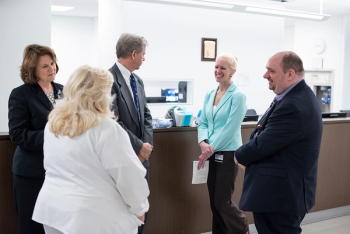
As the U.S. population ages into declining health, accompanied by mobility challenges in getting to healthcare providers, innovative solutions to care include bringing the health system and medical procedures to patients’ homes.

As the U.S. population ages into declining health, accompanied by mobility challenges in getting to healthcare providers, innovative solutions to care include bringing the health system and medical procedures to patients’ homes.

Adrienne Boissy learned early on in her career that being present in the moment for her patients was more important than trying to fix them.

MCOs are stepping up their game to ensure members are highly satisfied with their services. Here are some strategies to consider.

A study from Doximity has shocking statistics about oncologist shortages in the U.S. Here’s how you should react.

Here are ways healthcare execs can increase cancer awareness efforts.

This revolutionary therapy raises serious financial questions. Here’s how much it costs, and how payers are responding.

Because the mutational burden and the genetic characteristics of children are different from adults, pediatric cancer should be diagnosed and treated differently. Here’s how.

One expert shares three things providers can do to improve their performance in the OCM program.

How Froedtert Hospital achieves success with a 24/7/365 cancer clinic.

What if your healthcare organization could not only create a plan to retain more millennials as employees, but could hook them before they even graduate from school? Here’s how one healthcare system is doing it.

Ochsner Health System’s brings early-stage clinical trials to the Gulf South region.

Payers struggle to determine the appropriate criteria for covering innovative treatments and providers want to increase patient access. Patients’ lives can hang in the balance.

Onboarding new oncology patients can be a delicate process to help them prepare for their care journey. Here are the first steps.


Eastern Maine Healthcare System’s program helps up-and-coming leaders gain the skills to best situate the healthcare organization for future success


Ready to conquer your email inbox? Here are tips for healthcare executives.

A less-invasive approach takes a personalized medicine approach to cancer care.

While we can’t help you cut down on your responsibilities, we can help you work more efficiently so that, hopefully, you won’t need to work so much.

How healthcare executives can ensure they are always in the best position to take advantage of the next career opportunity.

Two oncology practices have wish list items for payers. Find out what they are.

In this era of precision oncology and targeted therapies for cancer, it’s even more important to include different populations when doing clinical trials. Here are three effective strategies.

A nonprofit organization is helping turn the tide on readmissions in North Carolina. The small steps it’s taking are resulting in big differences.

What does team-based cancer care done right look like? Here are two real-word models worth emulating.

These tools will reduce healthcare costs and improve care quality.

Treating patients with cancer is often challenging yet rewarding work. But caring for patients in an urban setting, where some patients don’t speak English and other patients aren’t fully insured and possibly facing significant financial challenges.

Montefiore Medical Center in Bronx, New York, is participating in CMS’ oncology care model, a value-based payment arrangement. Find out what new group of staff members is helping it succeed.

The Center for Blood and Cancer Disorders in Fort Worth, Texas, is participating in many value-based contracts. Here’s how it is successful.

Ron Barkley, president of the Cancer Center Business Development Group, which consults with oncology providers on value-based care arrangements, shares tips.
